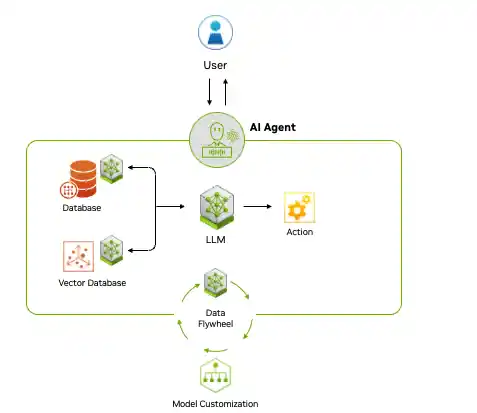Table of Contents
In a world where digital transformation is no longer a luxury but a necessity, the emergence of Agentic AI stands at the forefront of innovative technology, promising to revolutionize the way industries operate and excel. As organizations strive to adapt to an ever-evolving landscape, the integration of Agentic AI represents a strategic move towards enhancing innovation, driving growth, and securing a competitive edge in the market.
Understanding Agentic AI
It embodies a paradigm shift in artificial intelligence, embodying autonomous systems that possess the ability to learn, adapt, and make decisions independently, mirroring human cognitive capabilities.
By combining advanced machine learning algorithms with self-governing mechanisms,It transcends traditional AI applications, offering unparalleled opportunities for organizations to optimize processes, anticipate trends, and innovate with agility.
Applications of Agentic AI
- The transformative potential of Agentic AI is vividly demonstrated through industry-specific case studies that illuminate its impact across diverse sectors.
- From predictive analytics in finance to personalized healthcare solutions, Agentic AI has reshaped operational practices, enhanced customer experiences, and propelled digital transformation initiatives with remarkable success.
- By enabling organizations to harness data-driven insights, automate complex tasks, and deliver hyper-personalized services, Agentic AI has become a cornerstone for achieving operational excellence and sustainable growth in a digital-first world.
Implementing Agentic AI Strategies
- The successful implementation of Agentic AI strategies hinges on a strategic framework that blends technology, talent, and organizational culture. The seamless integration of Agentic AI into existing systems ensures consistent performance improvements and fosters scalable innovation across departments.
- Organizations must establish a roadmap for deployment that aligns with business objectives, fosters cross-functional collaboration, and nurtures a culture of continuous innovation.
- Tools like a no code AI agent builder can further simplify the implementation process, enabling teams without deep technical expertise to prototype and deploy custom AI agents quickly and efficiently.
- By emphasizing knowledge sharing and upskilling initiatives, organizations can empower employees to embrace the potential of driving transformative change and unlocking new avenues for growth.
Transformative Impact
- Across industries, the transformative impact of AI is palpable, with organizations reaping the rewards of improved efficiency, enhanced decision-making, and accelerated innovation cycles.
- By leveraging the autonomous capabilities of AI, businesses have been able to streamline operations, optimize resource allocation, and anticipate market shifts with unprecedented accuracy.
- This transformative technology is not only reshaping traditional business models but also creating new opportunities for disruptive innovation, setting the stage for sustained growth and competitive differentiation in a rapidly evolving marketplace.

Empowering Innovation and Growth
- At the heart of Agentic Artificial intelligence advancement lies a narrative of empowerment, innovation, and growth.
- By embracing this transformative technology, organizations are not only enhancing their operational efficiency but also fostering a culture of creativity, resilience, and adaptability.
- As it continues to drive innovation and growth across industries, it serves as a catalyst for unlocking new possibilities, driving sustainable development, and shaping the future of work in a digital age.
How Agentic AI Functions
Agentic AI follows a structured four-step problem-solving process:
- Perceive : AI agents assimilate and process data from an array of sources like sensors, databases, and digital interfaces. This step involves extracting meaningful features, identifying objects, and recognizing pertinent entities within the environment.
- Reason : A robust language model performs the role of orchestrator, serving as the reasoning engine. This component comprehends tasks, generates solutions, and coordinates specialized models for specific functions such as content generation, vision processing, or recommendation systems. Techniques like retrieval-augmented generation (RAG) are employed to access proprietary data sources and furnish accurate, relevant outputs.
- Act : Through integration with external tools and software via application programming interfaces, it swiftly executes tasks as per its formulated plans. AI agents may have guardrails in place to ensure precise task execution: for instance, a customer service AI may internally process claims up to a specific amount, with human intervention required for claims exceeding said threshold.
- Learn : Through a feedback loop or “data flywheel,” agentic AI continuously refines itself, leveraging data from its interactions to enhance its models. This adaptive learning capability augments its effectiveness over time, furnishing businesses with a potent asset to propel improved decision-making and heightened operational efficiency.

Conclusion
The transformative leap in artificial intelligence, offering advanced problem-solving capabilities that drive innovation, efficiency, and growth across industries. By harnessing sophisticated reasoning and autonomous decision-making, Agentic AI empowers organizations to enhance operations, improve decision-making, and unlock new possibilities for success.
Embracing Agentic AI is not just a strategic choice—it’s a catalyst for driving sustainable progress, shaping the future of work, and staying ahead in the dynamic world of technology and business.